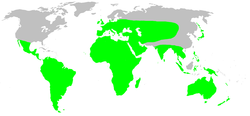Ant spider: Difference between revisions
mNo edit summary |
|||
| Line 99: | Line 99: | ||
:* ''[[Tropasteron]]'' Baehr, 2003 |
:* ''[[Tropasteron]]'' Baehr, 2003 |
||
:* ''[[Zillimata]]'' Jocqué, 1995 |
:* ''[[Zillimata]]'' Jocqué, 1995 |
||
| ⚫ | |||
* ''[[incertae sedis]]'' |
* ''[[incertae sedis]]'' |
||
| Line 116: | Line 114: | ||
:* ''[[Zodariellum]]'' Andreeva & Tyschchenko, 1968 |
:* ''[[Zodariellum]]'' Andreeva & Tyschchenko, 1968 |
||
| ⚫ | |||
:* ''[[Akyttara]]'' Jocqué, 1987 |
:* ''[[Akyttara]]'' Jocqué, 1987 |
||
:* ''[[Diores (spider)|Diores]]'' Simon, 1893 |
:* ''[[Diores (spider)|Diores]]'' Simon, 1893 |
||
Revision as of 08:43, 15 July 2007
| Zodariid ground spiders | |
|---|---|
| Scientific classification | |
| Kingdom: | |
| Phylum: | |
| Class: | |
| Order: | |
| Section: | |
| Superfamily: | Zodarioidea
|
| Family: | Zodariidae |
| Genera | |
|
Habronestes | |
| Diversity | |
| 72 genera, 828 species | |

| |
The Zodaraiid ground spiders or ant spiders, are a family (Zodaraiidae) of small to medium-sized eight-eyed spiders. They are found world-wide in tropical to warm temperate regions, though there are relatively few species in North America.
Some zodariids are ant mimics. Although ant mimicry is quite common in spiders, the form it takes in the zodariids is unusual because, although each species bears a morphological resemblance to the species of ant that forms its prey, the resemblance is not particularly close. It is enhanced by the spider's behaviour. The spiders live in association with a nest of ants of their prey species, and use their mimicry to enter and leave the nest unmolested (if the ants detected them as intruders they would mass to repel and perhaps kill them). The spiders walk on only the three rear pairs of legs, and if they encounter an ant during their forays into the nest territory, they touch their front legs to the ant's antennae in the same way as another ant would with its own antennae. If they have already captured an ant, they then offer that towards the challenging ant, which inspects it and behaves towards the spider as if it were another ant carrying a dead conspecific away from the nest (a common behaviour among ants).
It is likely that the spiders also derive some protection against predation from their similarity to the ants, since ants are unpalatable to many species that eat spiders.
Systematics
The categorization into subfamilies follows Joel Hallan's Biology Catalog.
- Cydrelinae Simon, 1893
- Aschema Jocqué, 1991
- Caesetius Simon, 1893
- Capheris Simon, 1893
- Cydrela Thorell, 1873
- Eocydrele Petrunkevitch, 1958 † (fossil)
- Procydrela Jocqué, 1999
- Psammoduon Jocqué, 1991
- Psammorygma Jocqué, 1991
- Rotundrela Jocqué, 1999
- Cyriocteinae Jocqué, 1991
- Cyrioctea Simon, 1889
- Lachesaninae Jocqué, 1991
- Antillorena Jocqué, 1991
- Australutica Jocqué, 1995
- Lachesana Strand, 1932
- Lutica Marx, 1891
- Sterenomorphinae Simon, 1893
- Chariobas Simon, 1893
- Cicynethus Simon, 1910
- Madrela Jocqué, 1991
- Storenomorpha Simon, 1884
- Thaumastochilus Simon, 1897
- Storeninae Simon, 1893
- Amphiledorus Jocqué & Bosmans, 2001
- Asceua Thorell, 1887
- Asteron Jocqué, 1991
- Basasteron Baehr, 2003
- Cavasteron Baehr & Jocqué, 2000
- Chilumena Jocqué, 1995
- Cybaeodamus Mello-Leitão, 1938
- Euasteron Baehr, 2003
- Forsterella Jocqué, 1991
- Habronestes L. Koch, 1872
- Hermippus Simon, 1893
- Hetaerica Rainbow, 1916
- Ishania Chamberlin, 1925
- Leprolochus Simon, 1893
- Leptasteron Baehr & Jocqué, 2001
- Mallinella Strand, 1906
- Minasteron Baehr & Jocqué, 2000
- Neostorena Rainbow, 1914
- Nostera Jocqué, 1991
- Pax Levy, 1990
- Pentasteron Baehr & Jocqué, 2001
- Phenasteron Baehr & Jocqué, 2001
- Platnickia Jocqué, 1991
- Pseudasteron Jocqué & Baehr, 2001
- Selamia Simon, 1873
- Spinasteron Baehr, 2003
- Storena Walckenaer, 1805
- Storosa Jocqué, 1991
- Subasteron Baehr & Jocqué, 2001
- Tenedos O. P.-Cambridge, 1897
- Tropasteron Baehr, 2003
- Zillimata Jocqué, 1995
- Adjutor Petrunkevitch, 1942 † (fossil)
- Admissor Petrunkevitch, 1942 † (fossil)
- Anniculus Petrunkevitch, 1942 † (fossil)
- Colima Jocqué & Baert, 2006
- Epicratinus Jocqué & Baert, 2006
- Euryeidon Dankittipakul & Jocqué, 2004
- Heradion Dankittipakul & Jocqué, 2004
- Holasteron Baehr, 2004
- Masasteron Baehr, 2004
- Notasteron Baehr, 2005
- Tropizodium Jocqué & Churchill, 2005
- Zodariellum Andreeva & Tyschchenko, 1968
- Zodariinae Thorell, 1881
- Akyttara Jocqué, 1987
- Diores Simon, 1893
- Dusmadiores Jocqué, 1987
- Heradida Simon, 1893
- Mallinus Simon, 1893
- Mastidiores Jocqué, 1987
- Microdiores Jocqué, 1987
- Palaestina O. P.-Cambridge, 1872
- Palfuria Simon, 1910
- Ranops Jocqué, 1991
- Suffasia Jocqué, 1991
- Trygetus Simon, 1882
- Zodarion Walckenaer, 1826
See also
External links
- Full species and range listing available at the World Spider Catalog entry for Zodariidae
- Pictures of Zodariidae: Neostorena sp. Storena formosa S. obscura
